Keeping a link with your customer is easy but also difficult. Do you keep up with the pace and are in contact with your customers? There are various ways to do it. But only some ways are suitable for some businesses.
Transactions are being processed through many systems like Clover and Moneris. The systems enable fast transactions and in-depth details relating to the price, products, inventory, etc.
Platforms and systems are a bridge between customers and the business. This bridge gives details and coveted information like the trends of what consumers are choosing more or what they are buying against other products offered.
Introductions:
A virtual terminal or terminal emulator is a server or cloud-based terminal that enables access to information about the customers. The virtual terminal provides precious information about the products and how the customers perceive them through sales patterns.
VT is a web-based terminal that gives access to the business authorities to process transactions, mainly credit card transactions. The information on the cloud server can be accessed from anywhere, like; your mobile device.
You only need a device, internet access, and the account and password. The information is much more like at your fingertips at any given time.
The virtual terminal connects with a remote server to transfer a file or information. This information may be gathered through the transactions done through systems like Clover and Moneris. These systems are a great help in gathering all the important information.
The transactions done through these systems are recorded along with the product’s price, barcode, batch number, etc. all this information helps the business owner and other authoritative personalities make better decisions for the business and its growth.
Why does a Business needs Virtual Terminal?

A business is a big responsibility for the owner, but facilities like VT and systems like Clover and Moneris have made it easy to make the business successful.
The virtual terminal may only be needed to make a one-time payment, but the terminal is cloud-based, and the information gathered on the terminal can be used for multiple things, like; setting it up to pay recurring energy bills, etc.
The virtual terminal system comes in handy when there is no physical or direct link with the clients, service providers like; freelancers, etc., who do not know the client. Even orders for pickup or delivery use the cloud-based terminal to get information ad payment from the client.
How Does a Virtual Terminal Works?

A virtual terminal is an undeniably easy link between the business and the customers. The process is also plain and simple.
You will need a merchant account to enable the terminal emulator.
The steps are simple:
- Log in to the dashboard. These dashboards are linked to the systems like Clover, etc.
- Choose the payment type; it can be eCHECK, credit, etc.
- Enter the number of sales you expect
- Give the key-card number to the bank along with other details. You can also get a card insertion machine for the cards.
- To finish the process and the transaction, click the button
- This terminal will receive the information. These terminals also enable you to copy the information of the client’s purchases.
Through the virtual terminal, you can also refund the payments or get the details about the client. The basic purpose of the cloud-based terminal is to do transactions like Moneris.
Card-Not-Present Environment
A card-not-present transaction is also possible with the virtual terminal. It has more risk and runs on a trust basis. This is a good way of building trust with your old and loyal customers. However, with new customers, the business is taking more risk than building a strong relationship.
The key must be entered manually in the environment containing the CNP transaction. This transaction is also at a higher cost due to the risk involved. A credit and debit card is accepted in most small or big businesses, but payment without a card is doubtful. These payments, though, cost less than a typical card payment as for the card payment, the bank or the service provider charges a certain fee.
In CNP, the business has to believe the person providing information about the card, like the card number, pin, etc., is the actual account owner and not some random person trying to fake a payment.
Parties Benefiting from Virtual Terminal
A virtual terminal is not only limited to business transactions. Multiple parties can benefit from this cloud-based terminal that receives and stores specific and important information.
These parties are mostly not in direct contact with their clients; hence they use virtual terminal systems for the transaction. The parties include:
- Freelancers may not meet the client on a one-to-one basis, but they get the payment over the phone or through an online transaction from the clients for the service they provide.
- Restaurants for their drive-thru, delivery, and pick-up services
- Lawyers may not see the client in their office but take payment over the phone, email, etc.
- Doctors may be doing private practice and offering phone service to diagnose or even treat the patients. They can take payments via phone or email for the medical bill.
A business or a person can also initiate a payment schedule through the virtual terminal for the payments that have to be made after regular intervals.
Conclusion:
The virtual terminal is more like the system Clover and Moneris; the only difference is that the card or the person is not physically present to make the payment through the system. The system receives the payment through other channels like an online transfer, card details through phone or emails, etc.
The platforms further facilitate these systems, like the Odoo platform, as all the departments and the payments are synced under one umbrella. It is a win-win situation for all!